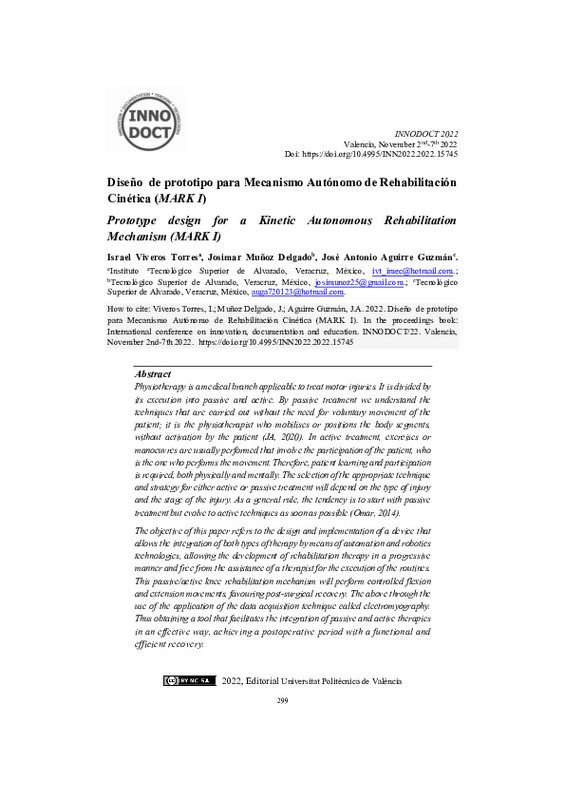JavaScript is disabled for your browser. Some features of this site may not work without it.
Buscar en RiuNet
Listar
Mi cuenta
Estadísticas
Ayuda RiuNet
Admin. UPV
Diseño de prototipo para mecanismo autonomo de rehabilitacion kinetica (MARK I)
Mostrar el registro sencillo del ítem
Ficheros en el ítem
| dc.contributor.author | Viveros Torres, Israel
|
es_ES |
| dc.contributor.author | Muñoz Delgado, Josimar
|
es_ES |
| dc.contributor.author | Aguirre Guzmán, José Antonio
|
es_ES |
| dc.date.accessioned | 2023-05-05T09:32:22Z | |
| dc.date.available | 2023-05-05T09:32:22Z | |
| dc.date.issued | 2023-04-04 | |
| dc.identifier.isbn | 9788413960364 | |
| dc.identifier.uri | http://hdl.handle.net/10251/193149 | |
| dc.description.abstract | [ES] La fisioterapia es una rama medica aplicable para tratar lesiones motrices, la cual implementa tecnicas para la rehabilitacion en forma mas rápida y eficiente para el paciente. Esta se divide por su ejecusion, en pasiva y activa. Por tratamiento pasivo entendemos las técnicas que se realizan sin necesidad de movimiento voluntario del paciente, es el fisioterapeuta el que moviliza o coloca los segmentos corporales, sin activacion por parte del paciente. En el tratamiento activo, se suelen realizar ejercicios o maniobras que implican la participación del paciente, que es el que realiza el movimiento. Por lo tanto, se requiere aprendizaje y participación del paciente, tanto a nivel físico como a nivel mental. La seleccion de la tecnica y estrategia adecuada para el tratamiento ya sea activo o pasivo, esto dependera del tipo de lesión y de la fase en que se encuentre. Por norma general, la tendencia es comenzar con tratamiento pasivo pero evolucionar a técnicas activas en cuanto sea posible. El objetivo del presente refiere al diseño e implementación de un dispositivo que permita integrar ambos tipos de terapia por medio de tecnologías de automatización y robotica, permitiendo el desarrollo de la terapaia de rehabilitacion en forma progresiva y libre de asistencia de una terapista para la ejecución de las rutinas. Este mecanismo rehabilitador pasivo/activo de rodilla realizara movimientos de flexión y extensión controlados, favoreciendo la recuperación postquirúrgica. Lo anterior a traves del uso de la aplicacion de la tecnica de adquisicion de datos denominada electromiografía. Obteniendo asi una herramienta que facilita la integración de las terapias pasiva y activas en forma eficaz, logrando tener un postoperatorio con una recuperación funcional y eficiente. | es_ES |
| dc.description.abstract | [EN[ Physiotherapy is a medical branch applicable to treat motor injuries. It is divided by its execution into passive and active. By passive treatment we understand the techniques that are carried out without the need for voluntary movement of the patient; it is the physiotherapist who mobilises or positions the body segments, without activation by the patient (JA, 2020). In active treatment, exercises or manoeuvres are usually performed that involve the participation of the patient, who is the one who performs the movement. Therefore, patient learning and participation is required, both physically and mentally. The selection of the appropriate technique and strategy for either active or passive treatment will depend on the type of injury and the stage of the injury. As a general rule, the tendency is to start with passive treatment but evolve to active techniques as soon as possible (Omar, 2014). The objective of this paper refers to the design and implementation of a device that allows the integration of both types of therapy by means of automation and robotics technologies, allowing the development of rehabilitation therapy in a progressive manner and free from the assistance of a therapist for the execution of the routines. This passive/active knee rehabilitation mechanism will perform controlled flexion and extension movements, favouring post-surgical recovery. The above through the use of the application of the data acquisition technique called electromyography. Thus obtaining a tool that facilitates the integration of passive and active therapies in an effective way, achieving a postoperative period with a functional and efficient recovery. | es_ES |
| dc.format.extent | 9 | es_ES |
| dc.language | Español | es_ES |
| dc.publisher | Editorial Universitat Politècnica de València | es_ES |
| dc.relation.ispartof | Proceedings INNODOCT/22. International Conference on Innovation, Documentation and Education | |
| dc.rights | Reconocimiento - No comercial - Compartir igual (by-nc-sa) | es_ES |
| dc.subject | Fisioterapia | es_ES |
| dc.subject | Rehabilitación | es_ES |
| dc.subject | Robótica | es_ES |
| dc.subject | Elecromiografía | es_ES |
| dc.title | Diseño de prototipo para mecanismo autonomo de rehabilitacion kinetica (MARK I) | es_ES |
| dc.type | Capítulo de libro | es_ES |
| dc.type | Comunicación en congreso | es_ES |
| dc.identifier.doi | 10.4995/INN2022.2022.15745 | |
| dc.rights.accessRights | Abierto | es_ES |
| dc.description.bibliographicCitation | Viveros Torres, I.; Muñoz Delgado, J.; Aguirre Guzmán, JA. (2023). Diseño de prototipo para mecanismo autonomo de rehabilitacion kinetica (MARK I). En Proceedings INNODOCT/22. International Conference on Innovation, Documentation and Education. Editorial Universitat Politècnica de València. 299-307. https://doi.org/10.4995/INN2022.2022.15745 | es_ES |
| dc.description.accrualMethod | OCS | es_ES |
| dc.relation.conferencename | INNODOCT 2022 | es_ES |
| dc.relation.conferencedate | Noviembre 02-07, 2022 | es_ES |
| dc.relation.conferenceplace | Valencia, España | es_ES |
| dc.relation.publisherversion | http://ocs.editorial.upv.es/index.php/INNODOCT/INN2022/paper/view/15745 | es_ES |
| dc.description.upvformatpinicio | 299 | es_ES |
| dc.description.upvformatpfin | 307 | es_ES |
| dc.type.version | info:eu-repo/semantics/publishedVersion | es_ES |
| dc.relation.pasarela | OCS\15745 | es_ES |








